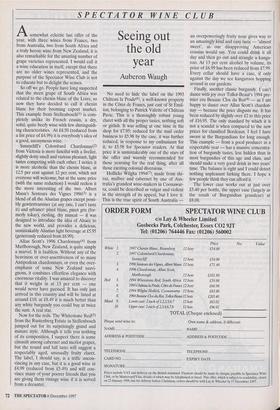SPECTATOR WINE CLUB
Seeing out the old year
Auberon Waugh
Asomewhat eclectic last offer of the year, with three wines from France, two from Australia, two from South Africa and a truly heroic wine from New Zealand, it is also remarkable for the amazing number of grape varieties represented. I would call it a wine education in itself, except that there are no older wines represented, and the purpose of the Spectator Wine Club is not to educate but to delight the senses.
So off we go. People have long suspected that the steen grape of South Africa was related to the chenin blanc of the Loire, so now they have decided to call it chenin blanc for their booming export market. This example from Stellenbosch(1) is com- pletely unlike its French cousin, a dry, solid, quite beefy wine with few distinguish- ing characteristics. At £4.50 (reduced from a list price of £4.99) it is everybody's idea of a good, anonymous wine.
Sunnycliffs Colombard Chardonnay(2) from Victoria is more fanciful with a livelier, slightly dotty smell and various pleasant, light tastes competing with each other. I notice it is more alcoholic than the chenin blanc, at 12.5 per cent against 12 per cent, which not everyone will welcome, but at the same price (with the same reduction) I would reckon it the more interesting of the two. Albert Mann's Senteurs des Vignes 1996(3) is a blend of all the Alsatian grapes except possi- bly gewiirztraminer (at any rate, I can't taste it) and sylvaner: pinot blanc, pinot gris (for- merly tokay), riesling, dry muscat — it was designed to introduce the idea of Alsace to the new world, and provides a delicious, unmistakably Alsatian light beverage at £5.95 (generously reduced from £6.99).
Allan Scott's 1996 Chardonnay(4) from Marlborough, New Zealand, is quite simply a marvel. It is faultless. Without any of the heaviness or over-assertiveness of so many Antipodean chardonnays, or even the over- emphasis of some New Zealand sauvi- gnons, it combines effortless elegance with enormous vitality. I was amazed to discover that it weighs in at 13 per cent — one would never have guessed. It has only just arrived in this country and will be listed at around £10; at £8.49 it is much better than any white burgundy you could buy at twice the sum. A real star.
Now for the reds. The Whitestone Red(5) from the Rustenberg Estate in Stellenbosch jumped out for its surprisingly grand and mature style. Although it tells you nothing of its composition, I suspect there is some cinsault among cabernet and merlot grapes, but the round and full taste will suggest a respectably aged, unusually fruity claret. The label, I should say, is a trifle uncon- vincing in any case, but it is a good wine at £4.99 (reduced from £5.49) and will con- vince many of your poorer friends that you are giving them vintage wine if it is served from a decanter, No need to hide the label on the 1993 Château la Prade(6), a well-known property in the ates de Francs, just east of St Emil- ion, belonging to Patrick Valette of Château Pavie. This is a thoroughly robust young claret with all the proper tastes, nothing soft or girlish. It was selling at one time in the shop for £7.95; reduced for the mail order business to £5.98 by the case, it was further reduced, in response to my enthusiasm for it, to £5.58 for Spectator readers. At that price it is unmistakeably one of the stars of the offer and warmly recommended for those yearning for the real thing, after all those exciting colonial diversions.
Hollicks Wilgha 1994(7), made from shi- raz, malbec and cabernet by one of Aus- tralia's grandest wine-makers in Coonawar- ra, could be described as vulgar and violent in the strength of its appeal, but I love it. This is the true spirit of South Australia — an overpoweringly fruity nose gives way to an amazingly kind and easy taste — 'almost sweet', as our disapproving American cousins would say. You could drink it all day and then go out and strangle a kanga- roo. At 13 per cent alcohol by volume, its price of £6.99 has been reduced from £7.99. Every cellar should have a case, if only against the day we see kangaroos hopping around in our gardens.
Finally, another classic burgundy. I can't dance with joy over Tollot-Beaut's 1994 pre- mier cru Beaune Clos du Roi(8) — as I am happy to dance over Allan Scott's chardon- nay — because the price disgusts me. It has been reduced by slightly over £2 to this price of £16.95. The only standard by which it is not a scandal is when compared to the new prices for classified Bordeaux. I feel I have sworn at the Burgundians for long enough. This example — from a good producer in a respectable year — has a massive concentra- tion of burgundy tastes, less hidden than in most burgundies of this age and class, and should make a very good drink in two years' time. The balance is right and I could detect nothing unpleasant lurking there. I hope a few people think they can afford it.
The lower case works out at just over £5.40 per bottle, the upper case (largely as the result of Burgundian grandeur) at £8.08.


















































































 Previous page
Previous page